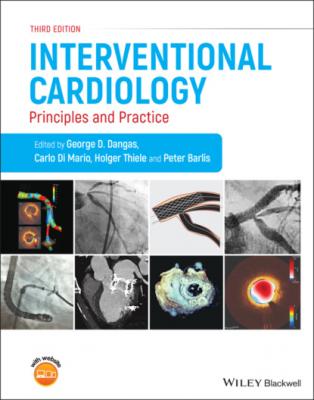Interventional Cardiology. Группа авторов
Читать онлайн.| Название | Interventional Cardiology |
|---|---|
| Автор произведения | Группа авторов |
| Жанр | Медицина |
| Серия | |
| Издательство | Медицина |
| Год выпуска | 0 |
| isbn | 9781119697381 |
Radial artery occlusion (RAO)
RAO is the most common post‐procedural complication of transradial access. Patients are often asymptomatic and hand function is unaffected (irrespective of Allen’s or Barbeau test) due to collateral perfusion. However, RAO precludes future radial artery procedures including repeat cardiac catheterization, arterial graft harvesting for coronary artery bypass grafts, and arteriovenous fistula formation in end stage renal failure patients [46]. Therefore, multiple strategies are available to minimize RAO including avoidance of repeat arterial puncture, a low sheath to artery size ratio, administration of intraprocedural heparin, and maintenance of radial artery patency during hemostasis after transradial access. More recently, there has been evidence suggesting that ipsilateral ulnar artery compression post‐procedure facilitates radial artery recanalization and reduces RAO (from 3.0% to 0.9% in a single center study) [47]. Most occlusions will recanalize after one month [48].
Catheter kinking and/or entrapment
Kinking can occur with excessive catheter torque and will prevent guide advancement or coronary manipulation unless resolved (Figure 3.3c). Counter‐rotating the knot is often all that is required to unkink the catheter. More advanced methods include unkinking whilst applying external fixation with the blood pressure cuff; counter‐traction from an alternate access site using a snaring device or encasing the knot with a larger sheath [49].
Hemostasis techniques
Post‐procedure, hemostasis techniques aim to minimize bleeding and prevent RAO. Mechanical support bands that encircle the wrist aim to compress the radial artery allowing “patent hemostasis” with preservation of antegrade blood flow. Aggressive compression results in no‐flow states and predicts subsequent RAO [48]. We prefer a practical approach to patent hemostasis whereby the operator occludes using air into the compression device, removes air until the puncture begins to bleed before inserting 1–2cc more air into the compression device. Other patent hemostasis techniques that can minimize RAO include use of plethysmography (Barbeau test) or mean arterial pressure (via TR band attached to sphygmomanometer) to achieve hemostasis whilst sustaining antegrade flow [50].
The TR band (Terumo, Tokyo, Japan), PreludeSYNC (Merit, Utah, USA) and the Radistop (RADI, Uppsala, Sweden) are all commonly used compressive devices (Figure 3.5).
Figure 3.5 Distal radial access set up and hemostasis. (a) Hand into Starboard or sitting in anatomical position beside right groin. (b) Sterile aperture drape applied over snuffbox (note hand position with wrist slightly pronated in ulnar deviation to facilitate puncture. (c) Ultrasound guided puncture, note echo bright needle tip (red dotted arrow) entering anterior wall of distal radial artery (yellow dotted arrow). Bright carpal bone immediately under radial artery, (d) Sheath in situ. (e) Hemostasis using air filled compression bandage (Merit PreludeSYNC distal) (f) – TR band (with firm backing plastic removed) with green dot of maximum compression pressure appropriately 1–2 mm proximal to puncture site.
Future directions
Distal radial access
As noted above, the distal radial approach is a promising iteration of TRA and has been adopted in contemporary standard practice by many interventional cardiologists and radiologists worldwide (Figure 3.5). More data is needed, and multiple trials are currently underway (NCT03789279, NCT04171570, NCT04125992).
Radial and slender clubs
In the late 1990s, a school of Japanese interventional cardiologists began to expound the miniaturization of transradial coronary interventions[51]. They are passionate about downsizing catheters and devices (using sheathless techniques and 4 Fr catheters) in order to minimize vascular trauma, reduce hemostasis time and decrease contrast without compromising performance [52]. National radial clubs have formed to build data and exchange ideas on TRA for coronary and peripheral interventions [53].
“Safe femoral” strategy
Mechanical circulatory support devices and transcatheter valve interventions both require large bore access. The “safe femoral” strategy has been proposed to reduce complications associated with TFA [54]. This approach comprises four steps. The first involves fluoroscopic landmark assessment to locate the inferior border of the femoral head as the correct location for skin puncture. Following this, an ultrasound probe is placed over the femoral head to visualize both the bifurcation of the common femoral artery, which should be inferior to the intended catheterization point, and any anterior calcification that should be avoided. Next, a micropuncture (21‐gauge) needle punctures the femoral artery under ultrasound guidance before advancement of an 0.018″ wire into the common iliac artery. A 4 Fr or 5 Fr sheath can then be deployed. Finally, at the end of the case, a vascular closure device is used to achieve hemostasis. Despite these steps to minimize complications, the radial approach remains the default as it is still safer [54].
Conclusions
Over the past three decades, transradial access has emerged as the preferred technique for cardiac catheterization and interventions. The radial approach is safer than the femoral approach with reduction in major vascular and major bleeding complications and lower overall mortality. It improves patient comfort during the procedure, allows early mobilization in recovery and achieves better functional outcomes. Furthermore, set up time and procedure length are reduced with resultant laboratory cost savings [55]. With adequate preparation of the artery, increased operator experience, knowledge of complications and how to resolve them, access‐site crossover is rarely required. The future of transradial access is exciting and may evolve with refinements including distal radial access which is currently being evaluated in clinical trials.
Interactive multiple choice questions are available for this chapter on www.wiley.com/go/dangas/cardiology
References
1 1 Ferrante G, Rao SV, Jüni P et al. Radial Versus Femoral Access for Coronary Interventions Across the Entire Spectrum of Patients With Coronary Artery Disease. JACC: Cardiovascular Interventions 2016; 9:1419–1434.
2 2 Hamon M, Pristipino C, Di Mario C, et al. Consensus document on the radial approach in percutaneous cardiovascular interventions: position paper by the European Association of Percutaneous Cardiovascular Interventions and Working Groups on Acute Cardiac Care** and Thrombosis of the European Society of Cardiology. EuroIntervention. 2013 Mar; 8(11):1242–51. doi: 10.4244/EIJV8I11A192.
3 3
